in-cyprus 30 April 2020 - Josephine Koumettou
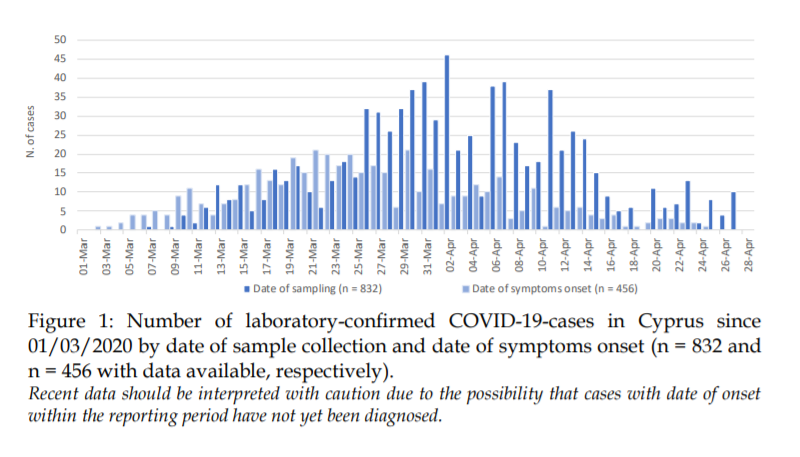
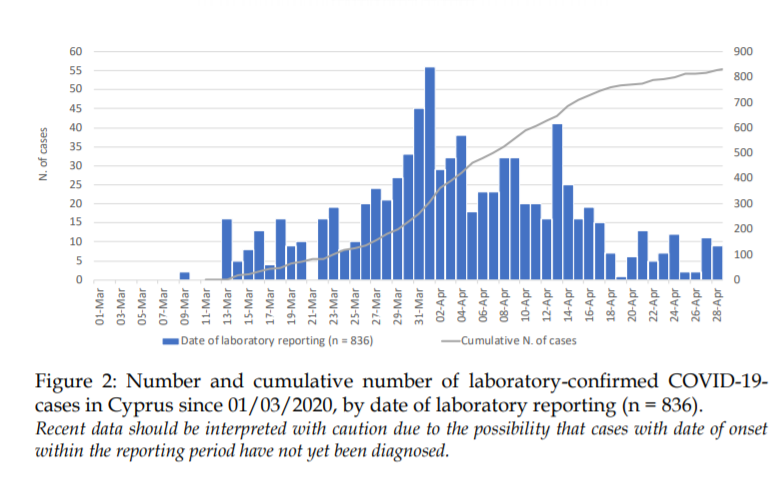
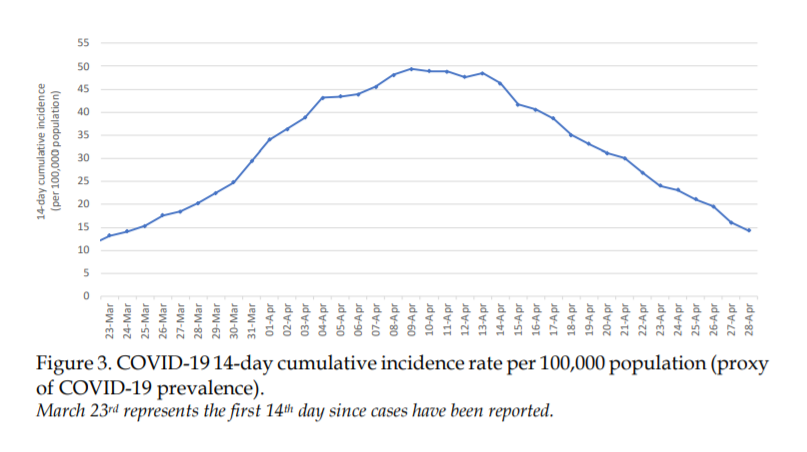
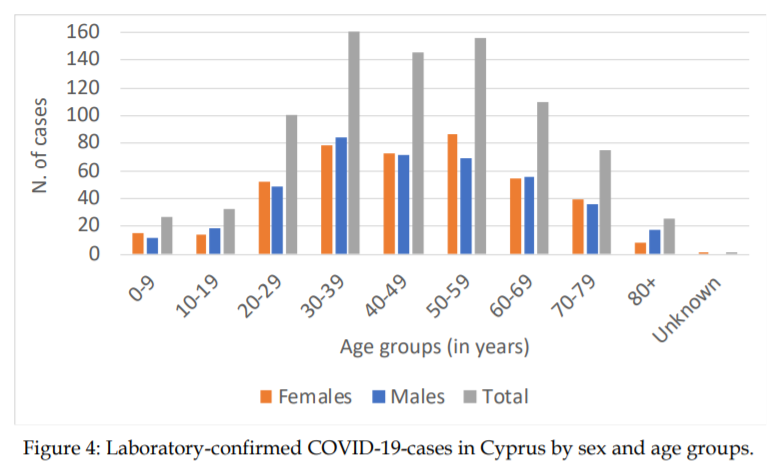
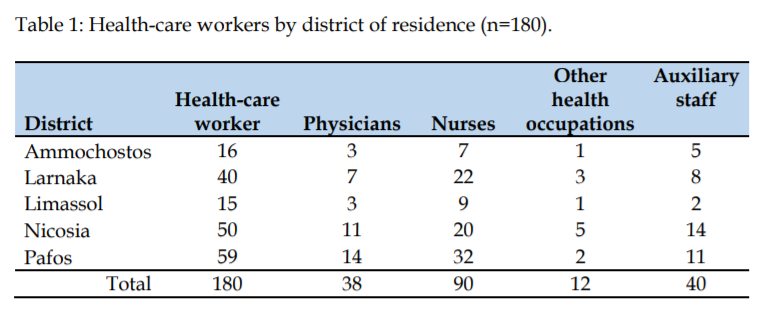
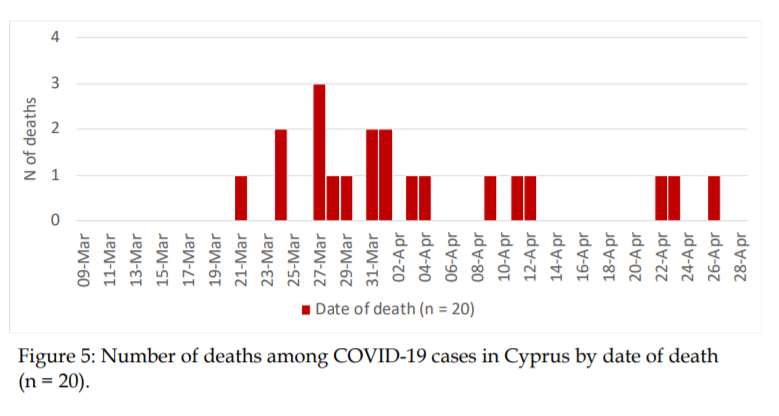
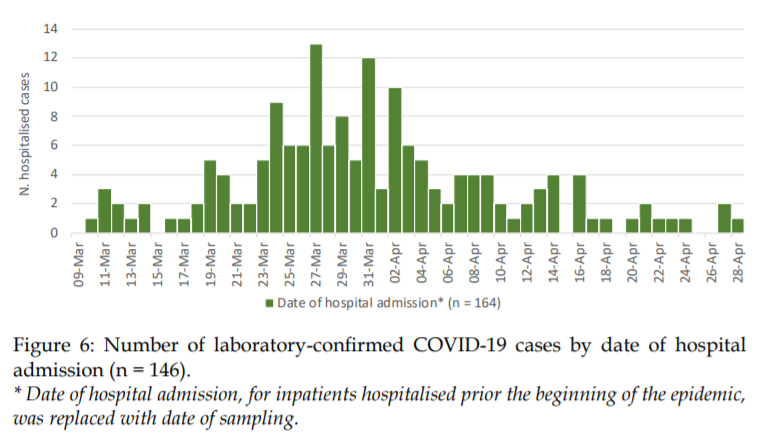

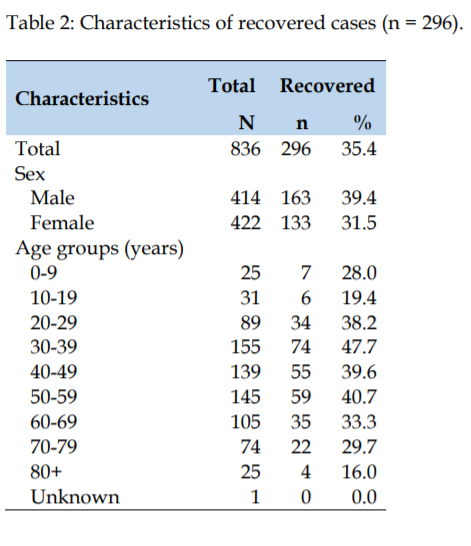
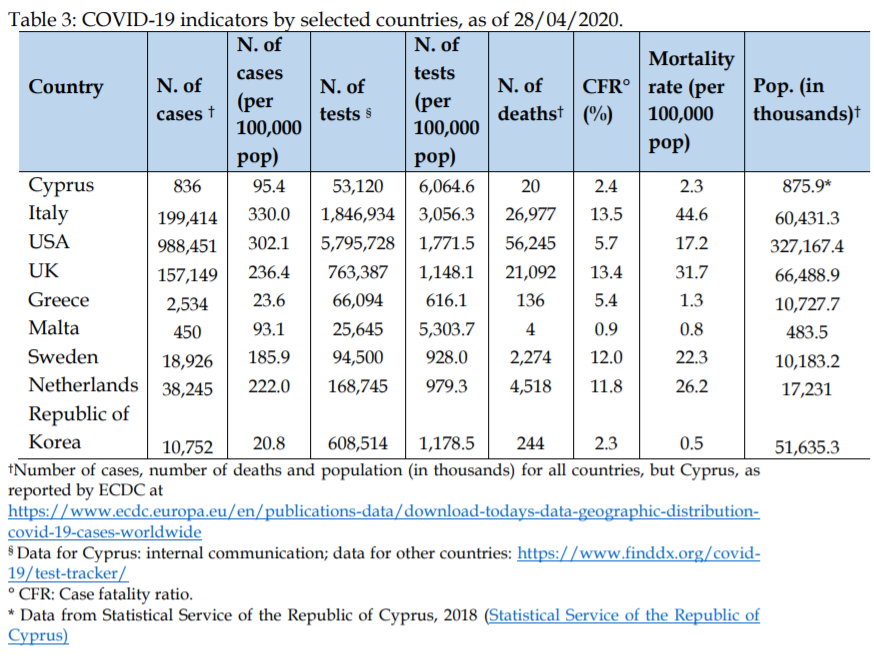
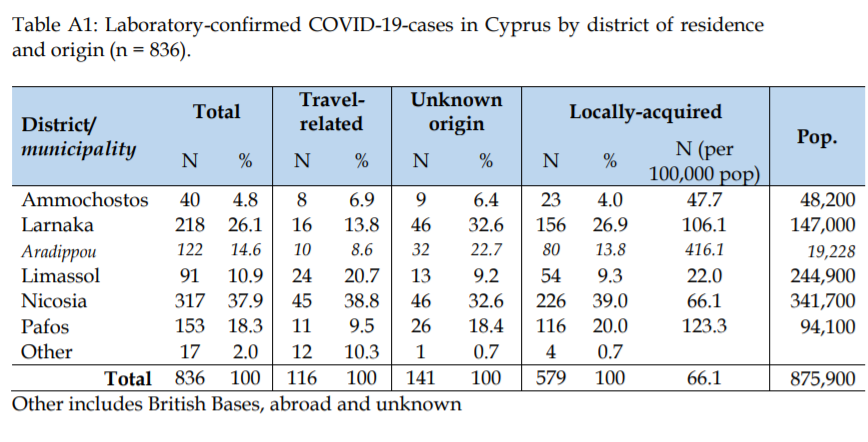

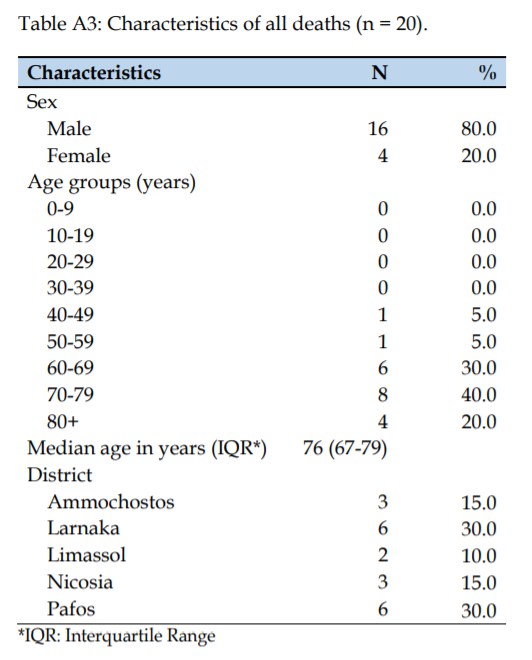


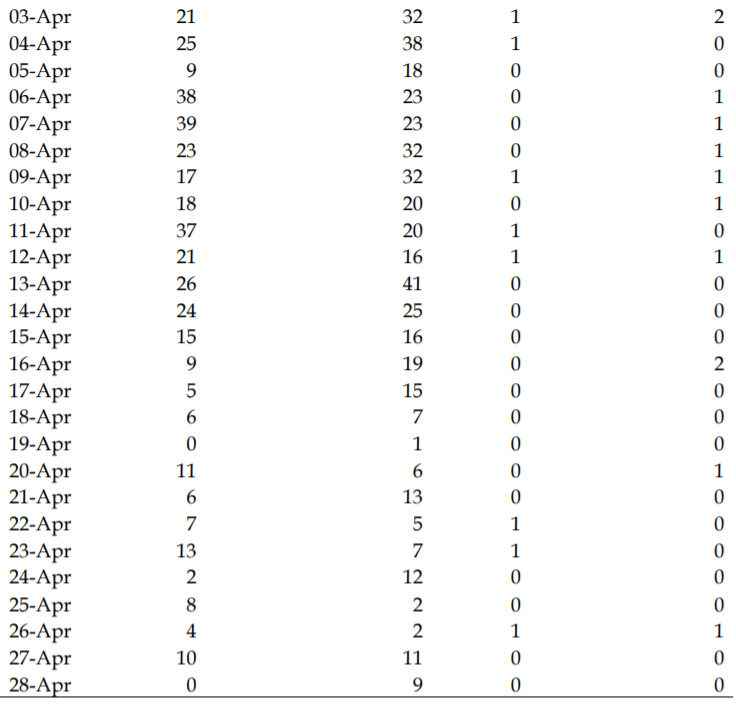

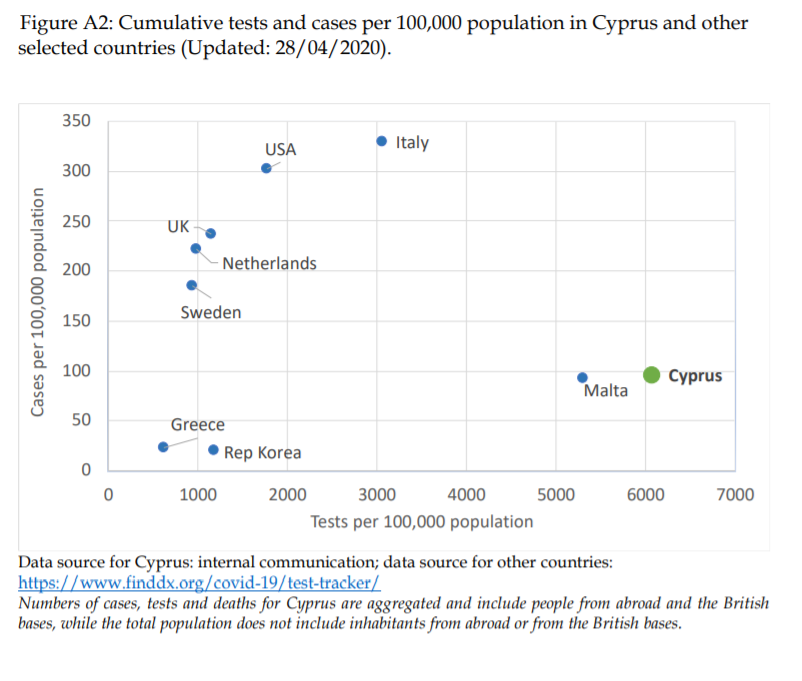
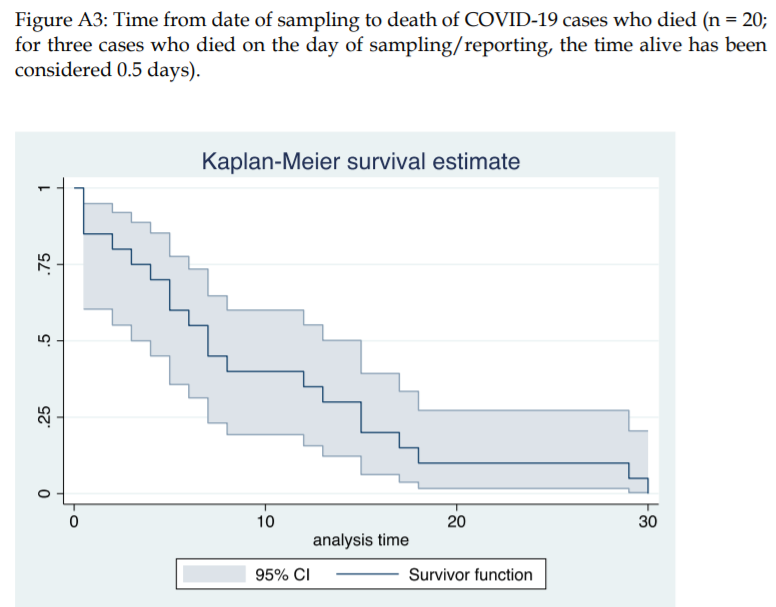
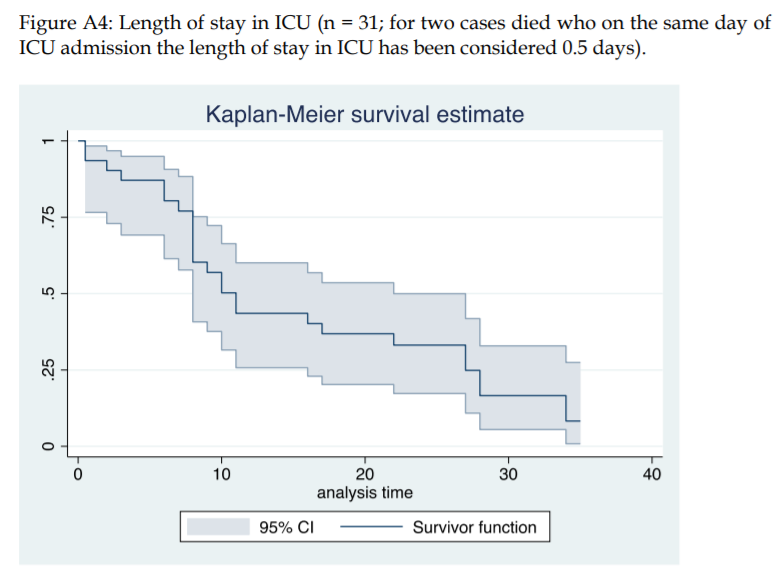
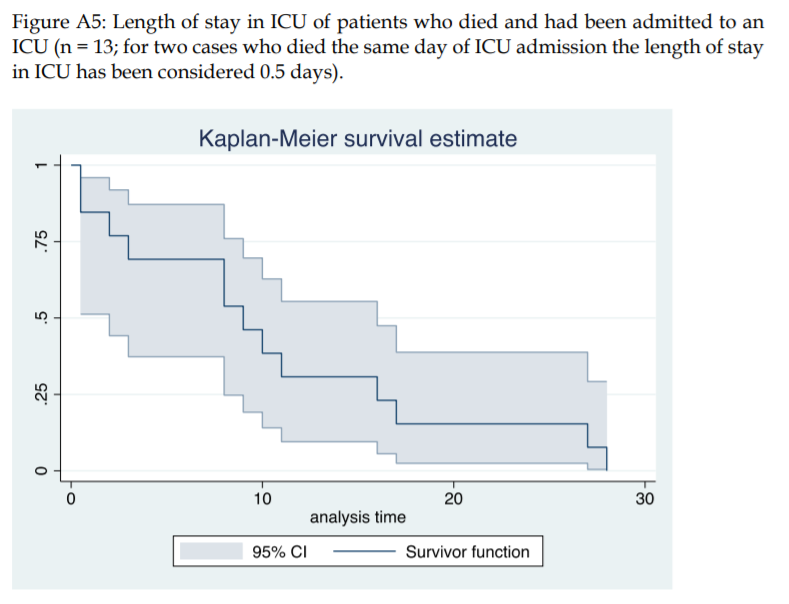
The latest report on Covid-19 by the Health Ministry’s Epidemiological Surveillance Unit with data up to April 28 reveals that 35.4% of people who tested positive to the virus in Cyprus have recovered.
In addition, 19.6% of cases received hospital care, of which 70.7% were discharged alive from the hospital (116 people).
The report also found that 53,120 tests were performed until April 28.
You can read the full set of data below.
Summary
As of April 28th, a total of 836 COVID-19 cases and 20 deaths (case fatality rate: 2.4%) have been reported in the Republic of Cyprus.
Among these cases, 21.5% are health-care workers (n = 180) – 4.5% physicians (n = 38), 10.8% nurses (n = 90), 1.4% other health occupations (n = 12), and 4.8% auxiliary staff (n = 40).
The median age of cases is 46 years (interquartile range – IQR: 32-60 years); 50.5% are female.
Overall, of 695 cases for which the place of exposure was known, locally acquired infections (index cases and close-contacts of confirmed cases) were 579 (83.3%) – of these 9.7% (n = 56) were related to a health-care facility (General Hospital in Pafos) and 13.8% (n = 80) were reported in Aradippou municipality.
In total, 19.6% (n = 164) of cases received hospital care, of which 116 (70.7%) have been discharged alive from the hospital. Median age of all hospitalized patients is: 62 years (interquartile range: 49.5-72.5 years), and 66.9% are males.
Six patients were still in intensive care units (for part of the day if they died, were discharged or transferred on that day or for the whole day, by April 28th); of these 4 (66.7%) were intubated.
Overall, 296 (35.4%) cases have recovered.
A total of 53,120 tests have been performed as of April 28th (6,064.6 per 100,000 population).
Epidemiological surveillance in the Republic of Cyprus
Analyses are based on laboratory-confirmed cases notified to the Epidemiological Surveillance Unit of the Ministry of Health.
As of April 28th, 836 laboratory-confirmed cases of coronavirus disease 2019 (COVID19) have been reported (Figure 1 and 2).
The median time between symptoms onset and date of sampling was 4 days (Interquartile range – IQR: 2-7 days). It should be noted that for 14 cases the date of sample collection was before the onset of symptoms because of immediate testing of contacts of possible and laboratory-confirmed cases.
As of April 28th, the 14-day cumulative incidence rate of COVID-19 (per 100,000 population), a measure which reflects the number of active COVID-19 cases in the population (prevalence), is 14.3 per 100,000 population (Figure 3).



Characteristics of the cases
Among these cases, 49.5% are male (n = 414) and 50.5% female (n = 422). The median age of cases is 46 years (IQR: 32-60 years). By age groups, cases included 51 infants, children and adolescents aged 0-17 years-old (6.1%), 574 adults aged 18-59 years (68.7%), and 210 persons aged 60 years and older (25.2%). The age of one notified case has not been recorded at the moment (Figure 4).

Among all cases, 317 (37.9%) were reported in Nicosia district, 218 (26.1%) in Larnaka, 153 (18.3%) in Pafos, 91 (10.9%) in Limassol, 40 (4.8%) in Ammochostos, and 14 (1.7%) were reported either in British bases or had a residence abroad, or information was not available (Table A1 in appendix).
Figure A1 in appendix shows the distribution of cases by postal code.
Notably, 122 cases (14.6%) were reported in Aradippou, a municipality in Larnaka district (Table A1 in appendix). Cases in Aradippou, including a cluster in a local bakery production line, are mainly males (59.0%; n = 72) and the median age is 49 years (IQR: 33-62 years). If the cluster is excluded, cases are mainly female (53.4%; n = 50) and the median age is 55 years (IQR: 40.5-69.5 years).
Among the 836 cases, 21.5% are health-care workers (n = 180), of which 4.5% physicians (n = 38), 10.8% nurses (n = 90), 1.4% other health occupations (n = 12), and 4.8% auxiliary staff (n = 40).
Table 1 shows the distribution of health-care workers by district of residence.

Epidemiological link
As of April 28th, place of exposure is available for 695 cases (83.1%).
In total, 16.7% (n = 116) of laboratory-confirmed COVID-19-cases had history of travel or residence abroad during the 14 days prior to symptom onset (imported). These cases have a direct link to the UK and Greece, mainly.
Locally acquired infections (index cases and close-contacts of confirmed cases) occurred in 83.3% (n = 579 of 695 with known place of exposure) of the cases, of which 9.7% (n = 56) were related to a health-care facility (General Hospital in Pafos).
Of all cases in Aradippou (Larnaka district) (n = 122), 80 (65.6%) were locally-acquired, 10 (8.2%) imported and for 32 cases (26.2%) the epidemiological link was not recorded at the moment.
Table A1 in the appendix shows the number and the rate (per 100,000 population) of locally-acquired cases by district of residence.
Clinical features
Of the 836 laboratory-confirmed COVID-19-cases, clinical information is available for 94.4% (n = 823), of which 29.5% (n = 243) reported no symptoms at diagnosis and 70.5% (n = 580) reported at least one symptom. The most commonly reported symptoms were:
cough (299/799; 37.4%),
fever (270/808; 33.4%),
myalgia (192/806; 23.8%),
sore throat (152/804; 18.9%),
anosmia (105/712; 14.7%), and
shortness of breath (104/790; 13.2%).
fever (270/808; 33.4%),
myalgia (192/806; 23.8%),
sore throat (152/804; 18.9%),
anosmia (105/712; 14.7%), and
shortness of breath (104/790; 13.2%).
Other reported symptoms were diarrhoea, runny nose, and headache.
Table A2 in appendix reports the sex and age distribution of asymptomatic cases at diagnosis.
Pre-existing conditions
Information on comorbidities was available for 720 (86.1%) cases. Of these, 305 (42.4%) reported at least one comorbidity.
The most commonly reported comorbidities were:
hypertension (119/700; 17.0%),
diabetes (66/704; 9.4%),
heart disease (60/700; 8.6%), and
cancer (18/433; 4.2%).
diabetes (66/704; 9.4%),
heart disease (60/700; 8.6%), and
cancer (18/433; 4.2%).
Other reported comorbidities were chronic kidney disease, autoimmune disease, and chronic respiratory disease.
Deaths
As of April 28th, 20 deaths were reported in Cyprus (Case Fatality Rate – CFR: 2.4%).
The mortality rate for COVID-19 is 2.3 per 100,000 population.
Sixteen deaths (80.0%) occurred in men and four (20.0%) in women; the median age of all deaths was 76 years (IQR: 67-79 years). Six deaths were reported among residents in Larnaka and in Pafos, each, three in Nicosia and Ammochostos, each, and two in Limassol (Appendix Table A3).
The median time from date of sampling to death was 7 days (IQR: 3.5-15.0 days).
Figure A3 shows the Kaplan-Meier curve of the time from date of sampling to death.
For 15 deaths, COVID-19 was the underlying cause of death (COVID-19 CFR: 1.8%).
Figure 5 reports the number of deaths by date.

Hospitalization and intensive care unit (ICU) admissions**
In total, 19.6% (n = 164) patients received hospital care, and 116 patients (70.7%) have been discharged alive from the hospital. The median age of hospitalized patients was 62 years (IQR: 49.5-72.5 years). Hospitalized cases were mainly males (n = 109; 66.5%).
Figure 6 shows the total number of hospital admissions by date.

Overall, 31 cases (18.9% of all hospitalized patients) have been admitted to ICU***, of which 6 were still in ICU (as of April 28th).
A total of 26 ICU patients (83.9% of all ICU patients) have been intubated, of which 4 (66.7% of all patients currently in ICU) are still intubated.
The overall median length of stay in ICU (for all 31 ICU cases, considering those still in ICU until 28th April) was 10 days (IQR: 7-27 days). Figure A4 shows the KaplanMeier curve of the length of stay in ICU.
**Data on hospitalisation and ICU are provisional and should be interpreted with caution because delay in data reporting is likely; for the construction of the curve, people are no longer in an ICU the day next to the date of their discharge, death or transfer.
***Intensive care unit (ICU) refers only to the ICU in Limassol General Hospital and to the ICU in Nicosia General Hospital.
***Intensive care unit (ICU) refers only to the ICU in Limassol General Hospital and to the ICU in Nicosia General Hospital.
For patients who died while in ICU (n = 13), the median length of stay in ICU was 9 days (IQR: 3-16). Figure A5 shows the Kaplan-Meier curve of the length of stay in ICU for the people who died.
For patients transferred/discharged alive from ICU (n = 12), the median length of stay in ICU was 9 days (IQR: 7.5-24.5 days).
The median age of patients ever admitted to ICU was 66 years (IQR: 56-76 years). ICU patients are mainly male (n = 22; 71.0%).
The number of cases currently in ICU is 0.7 per 100,000 population. For comparison, Italy and Lombardia reported the highest rates of 6.7 per 100,000 population (n = 4,068) and 13.8 per 100,000 population (n = 1,381) on April 3rd. The ICU rates in Italy and Lombardia on April 28th are 3.1 per 100,000 population (n = 1,863) and 6.6 per 100,000 population (n = 665)

Recovered
As of April 28th, 35.4% (n = 296) of COVID-19 cases have recovered*.
The median time between the second negative result and the first date of sampling was 18 days (IQR: 16-21 days); for two cases the dates of sampling were not available at the moment.
Table 2 shows the number and percentage of recovered cases and their characteristics.

*For symptomatic cases, or for cases hospitalised, a COVID-19 case can be considered cured after the resolution of symptoms and two negative tests for SARS-CoV-2 at 24-hour interval at least. For asymptomatic cases, or for persons isolated at home, the negative tests to document virus clearance should be obtained at a minimum of 14 days after the initial positive test (end of the quarantine period). Novel coronavirus (SARS-CoV-2). Discharge criteria for confirmed COVID-19 cases- When is it safe to discharge COVID-19 cases from the hospital or end home isolation? – Technical Report, 10 March 2020. Stockholm: ECDC; 2020
Comparison with selected countries
As of April 28th, in Cyprus the reporting rate was 95.4 cases per 100,000 population, the mortality rate was 2.3 deaths per 100,000 population and the CFR was 2.4%.
Table 3 shows COVID-19 indicators for Cyprus and other selected countries.
Figure A2 in appendix reports the rates of cumulative tests and cases (per 100,000 population) in Cyprus and other selected countries. In Cyprus the testing rate is 6,064.6 per 100,000 population.
It should be noted that the number of cases, tests and deaths for Cyprus are aggregated and include people from abroad and the British bases, while the total population does not include inhabitants from abroad or from the British bases.

Appendix











